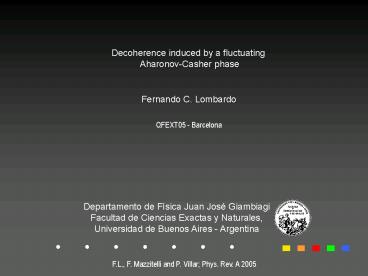Decoherence induced by a fluctuating
1 / 20
Title: Decoherence induced by a fluctuating
1
Decoherence induced by a fluctuating
Aharonov-Casher phase
Fernando C. Lombardo
QFEXT05 - Barcelona
F.L., F. Mazzitelli and P. Villar Phys. Rev. A
2005
2
(No Transcript)
3
How to explain the every day classical world
from quantum mechanics and the superposition
principle? Why are some systems always found in
classic states?
Paradigm classicality is an emergent property of
the open quantum systems
4
The interaction with the environment results in
an incessant monitoring of some of the
observables by the environmental degrees of
freedom
This is the decoherence process
5
The electrons became correlated with two
different states of the environment
6
- Classicality is an emergent property of the
quantum open system - The environment saves the information about the
path the electron takes.
7
Dephasing due to a noisy environment coupled to
the system
The uncertainty in the phase originates a
decaying term which tends to eliminate the
interference pattern
Formal equivalence A.Stern,Y.Aharonov and Y.Imry,
Phys.Rev A41,3436
8
For charged particles or neutral atoms with
dipole moment the interaction with the
environment is crucial ? induces a reduction of
fringe visibility
Double slit like experiment were studied in
presence of conductors. Mazzitelli, Paz,
Villanueva, Phys.Rev. A68,2003
They included a random variable t0 which
produces a fluctuating phase. In this simple
version of decoherence the role of quantum
environment is replaced by a time dependent
external classical field.
We evaluated the F factor for coherent neutral
particles with permanent dipole moments that are
affected by a time dependent external field.
9
For static fields, there is no force applied and
the phase does not depend neither on the velocity
nor on the trajectory. It is a topological phase
The Aharonov-Bohm phase
If fluctuations are determined by a Gaussian
probability distribution P(?), it is easy to see
that lt?gt0 and the overlap factor (or decoherence
factor) can be estimated by
A.Stern,Y.Aharonov and Y.Imry, Phys.Rev A41,3436
(1990) Jen-Tsung Hsiang and L.H.Ford, Phys. Rev.
Lett. 25, 250402 (2004)
If we know the average over noise of ?2 ?we can
estimate decoherence
10
The Aharonov-Casher phase
For static fields, it is only a topological phase
J.Anandan, Phys. Rev. Lett. 85, 1354 (2000)
11
The average over the random phase (generating a
classical noise) produces a decoherence factor
12
We will do it for different paths and will find
that the phases dependence with the velocity is
strongly related to the trajectory the particles
follow
This differs from the usual Aharonov-Casher
(which is a topological phase) because in the
time-dependent case there is a net force on the
particles.
For charged and neutral particles
We will assume they have similar velocities and
trajectories in order to compare.
13
If we want to have an estimation
14
Is this difference in behaviours seen for charged
particules? Yes
In both cases only the A coefficient contributed
to the C factor due to the parity of the
integrand with respect to the x and t axis.
15
Same contributions than the symmetric case
16
Independent of the velocity. Proportional to the
dimensions of the pipe
We can compute the decoherence factor for an
arbitrary TE and TM mode in a similar way.
17
It is not realistic to assume that charged and
neutral particles have the same velocity and
maximun separations. Therefore, we will introduce
some REAL numbers to our estimations
Assuming an energy flux of 10 Watts/cm2
In addition, for DIPOLES, one is allowed to
increase the intensity of the external field
since the scattering cross section for dipoles is
much smaller than for the electrons still within
the limit of neglible direct interaction between
the dipole and the field.
18
As the effect for dipoles is smaller than the
effect for electrons, we want to know how much we
can intensify the field so as to have an
observable effect or the same order of magnitude.
19
(No Transcript)
20
(No Transcript)































